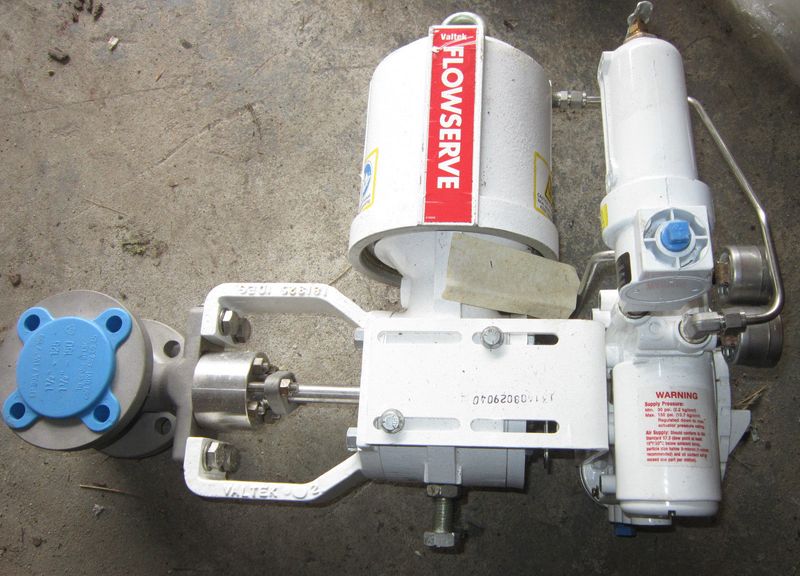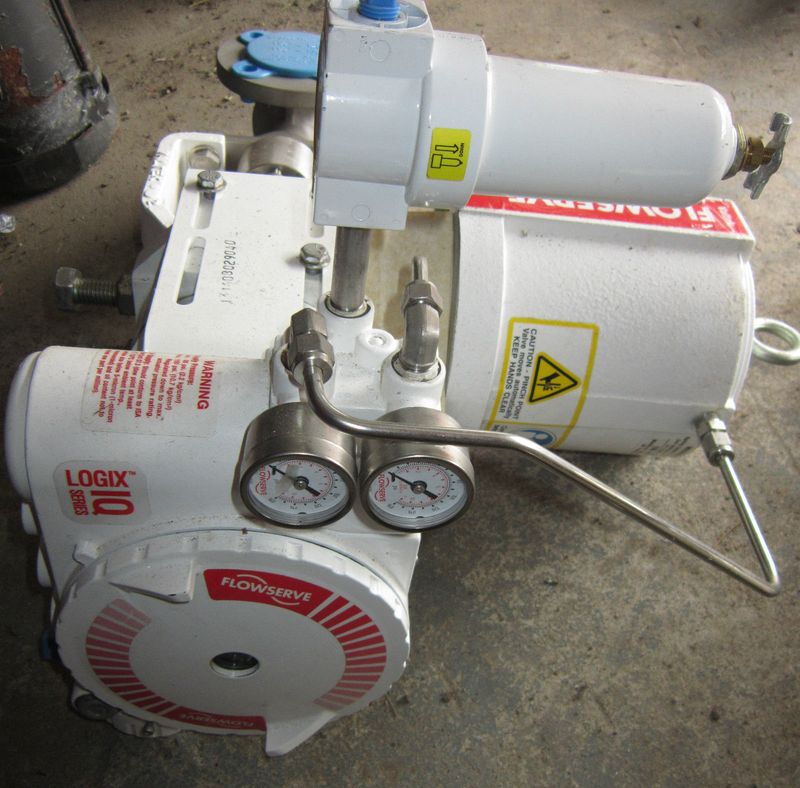
Welcome!
Be part of our community & join our international next generation forum now!
Categories
In this Discussion
- CothermanDistilling April 2015
- DocPorter April 2015
- grim July 2015
- Smaug July 2015
- TheMechWarrior July 2015
Steam Jacket Automation
On to another project! This one has been on hold until I could source what I thought was an appropriate valve. Valving on this setup is going to be a bit more complicated than valving on the reflux/product condenser, because the valve will need to be in close proximity to the still boiler, thus requiring classified electrics (or a pneumatic system, or both).
The approach here will be very similar to proportional control temperature systems, except we will be using jacket pressure (psig) as our process variable.
I was able to find a sweet heart deal on a Ferrari of a valve last night, so on this project goes!


Valtek 1.5" Maxflo 3 valve with 3200IQ digital positioner, explosion proof, intrinsically safe, etc. Takes a pneumatic line for valve positioning power, and a 4-20ma control signal to control valve position. Never used anything quite like this, so it'll be a learning experience for sure. Was not at all familiar with this kind of valve approach (eccentric rotary plug), but the rangeability looks far superior to a globe valve (160:1 vs 50:1), so it should fit the bill. We have a 2" line going down to 2 1" lines to the still, but this thing can open straight through, so no worries about reducing the steam feed to 1.5" for the valving. Will need to run an air line to the valve.
On the pressure side, we're using a WIKA 0-15psi pressure transducer/sender. It outputs a 4-20ma output based on pressure, 0psig = 4ma, 15psig = 20ma. This is a sweet little unit. For those of you with steam generators, or wanting to do something that's pressure based, but using temperature in lieu of pressure, take a look at the WIKA units, they are pretty slick. Only note, don't buy one that is larger in range than your application, you will absolutely lose resolution. In fact, the 0-15psi that I have, I really wish I had a 0-10psi instead. I don't need controllability on startup (12-15psi), but I do want the best accuracy possible in the control range (0-7psi probably). We are going to have the pressure transducer monitoring the jacket pressure.
Haven't yet decided on which PID controller we'll use for this one, but it doesn't need much more than a process input and process output. The nice thing about that sexy valve is the 3200iq positioner can calibrate for linearization, so the controller doesn't need to. I really want something that I can map the 4-20ma input current to a PSI reading on the controller. However, finding a unit that can do this is proving difficult. Might just need to bite the bullet and use the controller set to a ma reading, and maybe just post a cross-reference table next to it.
So, the overall approach very simple. Set the controller to the specific PSIG setting or mA setting that corresponds to the desired pressure, WIKA will monitor the jacket pressure, send the control signal to the PID, which will control the valve and steam feed. Not only should this give us solid controllability of the steam system (versus a hand-crank globe), but it should work to keep the jacket pressure rock solid. Will be very interested to see how fast this thing can respond, the spec says the actuation speed is below 1 second.
In the few times we've run the steam, it's pretty obvious that there is some minor variation in the steam pressure to the jacket as a result of the boiler pressure, to the extent of the cut in/cut out/deadband on the steam boiler controls. Someone running a higher pressure system and a regulator should see little to no variation in their low pressure steam line, but who really wants to deal with the headache of high pressure steam.




Comments
very cool... you could also build a little box with a 12v supply and a simple 2 resistor voltage divider circuit to get the 10V, then a pot for the 0-10V
Yeah, but I'd like to be able to dial in a target jacket pressure and have the PID control for the steam pressure variation in the main. As the steam boiler cycles, the main pressure probably moves between 9-10 to 12-13psi. This would be like having a wavering power supply on electric elements.
so you need this with as 4-20 output...
Thanks @grim, I'm looking at a steam jacketed boiler as well. Any idea what a new one of these is likely to cost?
If you needed to source new, or had limited options in surplus, I'd go with either a pneumatic globe valve, or a globe valve with actuator/positioner like the Johnson. The valve I posted has an outrageous list price, don't even bother with something like that unless you stumble on a deal.
When I was at Koval in Chicago, I noticed they were using a two-way Belimo LM24 on the steam line. I'd need to check my pictures again, but I believe it might have even been a ball valve. I know Johnson makes a high temperature spacer to move the valve away a bit and provide some thermal separation from the actuator.
If you are going for classified/zoned, the pneumatic will be the better approach, since you'll only be running an air line to the valve, and you don't need to worry about being EP or intrinsically safe. You can locate everything else far enough away to reduce the risk.
There are a number of manufacturers that make 4-20ma electropneumatic transducers, that take a 4-20ma and an air line, and vary the output pressure to position the valve. This stuff isn't too expensive, the brass valve is probably going to be the single biggest expense.
This was going to be the way I went if this thing didn't turn up. I was thinking of using 2 1" pneumatic globes, one on each steam line to the ports on the side. I'll have to post up a diagram, since my plumbing is a little bit more complex because I have the vacuum break and air vents on one side.
The only downside here is that they don't provide valve position feedback and you probably aren't dealing with a linear operation. In the real-world, probably irrelevant.
Just to make sure I understand this correctly. You are using a proportional valve because you have an on/off low pressure (15 psi) steam boiler. The valve is required to compensate for the surges from the boiler clicking on and off to provide a constant pressure to the still.
If you had a boiler with modulating valves this would not be required.
Also if you had a higher pressure boiler (100 psi) the pressure fluctuation after a regulator (set at 15psi) would be a little bit more smooth.
My situation is the last one and I just want to make sure my idea for using a manual globe valve isn't a foolish one.
Consistency and repeatability.
One thing I think the electric stillers take for granted is that they have rock solid power control. Little lag time, nearly perfect controllability and visibility.
Took me all of about 5 minutes with steam to realize that you don't newrly have the same rock solid control of power input. It's a bit more loose, it's ballpark.
Out where I am, greater than 15hp and 15psi, and you need a license to operate, also requires engineering. So for me, low pressure and no regulator is a no brainer. But like you say, without a regulator, you need to deal with the waver.
In the latter case, you'd be rock solid with a globe valve.
I don't have a modulating burner or the ability to set tighter bands.
Just found this read:
DIRECT STEAM INJECTION HOT WATER SYSTEMS FOR JACKETED HEATING by Philip Sutter @ Pick Heaters, Inc. (PDF)
Also, check eBay...plenty of Valtek products up at the moment.
Where the electric is affordable, the BMs are a super good solution. I had not realized how tricky the heat distribution was with steam.
Seems no matter what, an agitator is a requisite tool.
StillDragon North America - Your StillDragon® Distributor for North America
You'd be hard pressed to come up with an easier steam control method than a globe valve and a pressure gauge on the jacket. Look at all the fancy stills out of Europe, they are essentially all set up this way. For some of the fancier units, they use two parallel globe valves, one large and one small, to improve control at very low steam flow rates. Really though, not much different from the power control on an immersion element boiler. Turn the amperage up = turn the steam flow up.
My crazy valve approach is totally unnecessary. We have a 2" globe valve on the steam line to the still boiler today, works like a charm. The SD steam jacket boiler is very responsive.